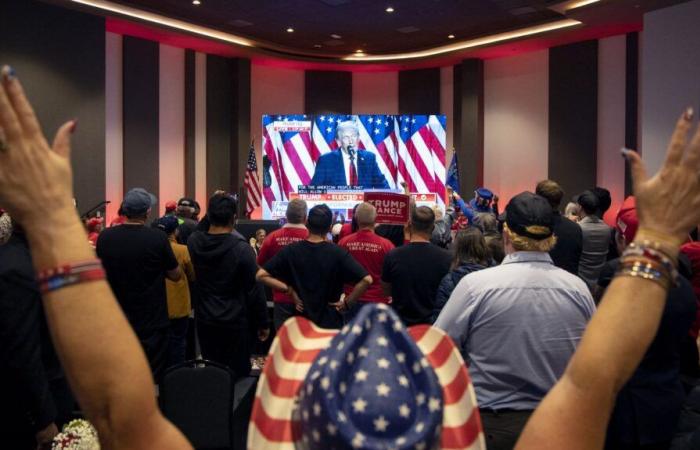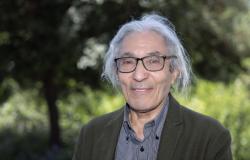
Trump 2, the return to Washington. Defying many predictions and the latest polls, Donald Trum succeeded in his bet by resoundingly beating Kamala Harris: returning to the White House, four years after leaving with a bang, and thus regaining his hat as President of the United States. This is a first since 1893 and the re-election of Grover Cleveland.
Seen from France, and more generally from Europe, it is sometimes difficult to understand the complexity of the American electorate. The states that could swing the election in favor of Donald Trump or Kamala Harris all made the same choice and gave their electors to the Republican camp. Immigration, downgrading and nostalgia for past greatness have weighed heavily on religious, rural and retired Americas. Panorama in a few maps.
The “Blue Wall”, a very fragile wall
In the United States, 18 states have always chosen the Democratic presidential candidate between 1992 and 2012. This “blue wall”, of which various political commentators dispute the authorship, is notably characterized by densely populated states, therefore able to guarantee a high number of electors. For the record, the candidate who obtains the majority of the popular vote in a state wins his entire electoral college, which will vote for him federally. And the number of electors depends on the population of the state.
Ideologically, the “Blue Wall” has no precise ideological definition. It brings together those who, while the Republican Party focused on the interests of white and rural populations as well as voters, felt ignored by the Republican Party, also nicknamed Grand Old Party (GOP). To summarize, the “blue wall” a priori brings together those to whom the Republican Party does not speak.
In 2016, this “Blue Wall” should have given Hillary Clinton victory over Donald Trump. But clearly, gaps appeared, and the Republican candidate won. Same scenario this year, but on a larger scale. The “Blue Wall” thus collapsed.
The “Rust Bowl”, symbol of American industrial decline
Until the mid-1980s, when we talked about this area of the northeastern United States, we spoke of the “industrial belt”, or “Manufacturing Belt” in original language. But the economic policies of Ronald Reagan did not spare this industrial basin, renamed the “rust basin”, “Rust Belt”, by Walter Mondale, Democratic candidate for the American presidential election in 1984.
The “Rust Bowl” therefore symbolizes the decline of coal, metallurgy, steel and the automobile industry, the activities which brought prosperity to the region in the 20th century.
It extends from Chicago to the Atlantic coast, and from the Canadian border to the Appalachians. Although it still concentrates 40% of industrial production in the United States, the “rust basin” has been marked since the 1980s by massive deindustrialization, with all its corollaries: endemic unemployment, increasing poverty, declining demographics and , sometimes, disaster cities, like Detroit.
How he voted: the “Rust Bowl”, it is hardly surprising, is today a mine of pivotal states. These states tilt an election because, taking into account the local economic and social context, the evolution of the population or the business climate, their voters have not made a definitive choice. Michigan, Wisconsin and Pennsylvania were among these “Purple States” (a mixture of red and blue). And it was Donald Trump who convinced in these economically weakened areas, undoubtedly sensitive to the candidate's promises in terms of purchasing power.
The “Sun Belt”, geographical reality but political abstraction
The “sun belt” refers to this southern third of the United States which, since the 1970s, has seen its economic, demographic and political weight explode. It extends from southern California to southern North Carolina, through Texas and into Oklahoma. In 1969, Kevin Phillips, the political analyst who coined the term “Sun Belt”, already described the phenomenon in The Emerging Republican Majoritye, in French). A particularly mild climate associated with abundant resources could only attract populations from a depressed north or cheap (and not unionized) labor from southern countries.
The “Sun Belt” nevertheless covers different economic and political realities. It is difficult to compare California, the beating heart of global high-tech, and South Carolina or Tennessee, agricultural states of the “deep south”, the Deep South.
Texas alone is a land of paradoxes, with a very progressive university and technological center around Austin and Houston and immense oil fields or agricultural lands in the north or east of the state. As for Florida, it feeds as much on NASA engineers as on a massive influx of retirees.
How she voted: the “Sun Belt” included several Swing States, these states disputed between the two candidates. Arizona, Nevada, Georgia and North Carolina. None of them resisted the Republican offensive. The Democrats have only convinced in their strongholds. The question of immigration, central in a border area with Mexico, undoubtedly played a determining role here.
The Midwest, a land of conquests
At the beginning of the 19th century, any territory beyond the Appalachians did not belong to the United States. It was the wild west, whose frontier gradually migrated. At the end of the 19th century, the so-called “civilized” lands of the West extended as far as Kansas or Nebraska. And the wild west was pushed beyond the Rockies.
In the middle of the 20th century, the American administration took note of a geographical reality by dividing the country into large regions: the northeast, the south, the west and, in the middle, the Midwest, “Heartland” for some. , the heart of America.
However, do the states in the region have any common features? From Michigan to North Dakota or from Illinois to Missouri, economic activities and population densities vary radically. Chicago accounts for almost 15% of the population, and the Great Plains have no more than 5 inhabitants per km2.
The area is highly industrialized in the northeast, where it intersects with the “Rust Belt” (above), and very rural to the south, where it merges with part of the “Corn Belt” (see below). There remain two points in common between all the states of the Midwest: they are at the crossroads of all the major transport networks and, for the most part, undergoing strong economic or demographic change.
How he voted: no surprise in the Midwest, traditionally won by the Republicans. Only one pivotal state could change the trend, Michigan, but it shifted to the Republican camp. The Heartland, as Americans call it, clings to a traditional image of the country. Donald Trump, who defended the greatness of the United States, undoubtedly finds an echo in very rural territories that are not very open to the world.
The “Bible Belt”, always faithful to its values
The “Bible Belt” refers to a region where religion has significant social and cultural weight. In Alabama (in the “Bible Belt”), barely 12% of the population says they are not religious, compared to 37% in Vermont (to the north). But here, when we speak of religion, it is the belief of the pioneers that we are talking about, baptizing, methodical, evangelical Protestantism in particular.
Unlike other regions of the United States, the area has little religious diversity. This is how we recognize it. In Tennessee, 52% of claimed believers are evangelicals, for example.
From North Carolina to Texas, from Arkansas to Georgia, we are therefore talking about a form of cultural unity, marked by a certain conservatism, but also by chronic difficulties. The general level of education in the “Bible Belt” is among the lowest in the country, teenage pregnancies are numerous and medical problems associated with precariousness are significant.
How she voted: No surprise here either, when we talk about the “Bible Belt,” we’re talking about conservative counties and states. Only the fringes of this area very attached to religious values voted for Harris, but there was no doubt on this point. And the Swing States of the “Bible Belt”, Georgia and North Carolina, gave their voters to Donald Trump.
“Corn Belt et “Barbecue Belt”…
The Corn Belt is a resurgence of the past. Initially, the region was defined by its monoculture, corn. In the American Midwest, conquered in the mid-19th century, this cereal occupied up to half of the cultivated land in Iowa, Illinois, Indiana and Ohio. But since then, agriculture has greatly diversified. And above all, its economic and political weight has declined. In the American electoral system, the states of the “Corn Belt” do not carry much weight. Even though, with the exception of Illinois, they are all Republicans today.
The “Barbecue Belt” is, for its part, an apolitical accident. North Carolina, South Carolina, Alabama, Kentucky, Texas, Missouri, and Tennessee share at least one tradition: barbecue. Some make holes in the ground, others smoke the meat for entire nights. All of them, in any case, refer to a moment of sharing, a form of conviviality specific to a certain southern culture. In 2024, this will not translate into openness to difference, diversity or sharing. The Barbecue Belt voted for Trump.





